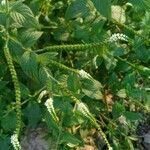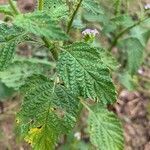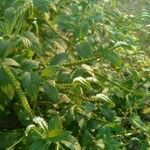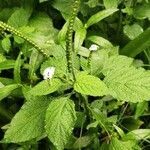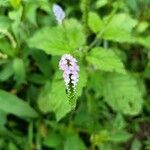Erect annual or a few times short-lived perennial herb up to 150 cm high. Stem quadrangular, thick, empty or pithed, woody to the base, variably hairy. Leaves alternate or subopposite; petiole 20-70(110) mm long, pubescent, with scattered bristles; lamina 40-170 x 30-130 mm, ovate to broadly ovate or triangular-ovate, strigose by areolae and with scattered bristles, roughish or only punctate above, generally pubescent-villous, rarely tomentose or punctate and with some scattered bristles mainly on the nerves and veins below, acute at the apex, obtuse to subcordate at the base and abruptly decurrent on the petiole, often with crisped margins; secondary nerves 4-8 on each side of the midrib. Cymes long and flexuous, up to 36 cm long when completely expanded, usually shorter, ± dense, single or sometimes in pairs, on a short terminal peduncle. Flowers sessile. Calyx lobes 1.5-3.5 mm long, narrowly elliptic to subulate, unequal, sparsely hispid. Corolla 3.5-5.0 mm long, hypocrateriform, pubescent outside, glabrous inside, white or rarely mauve or blue; tube 3.0-4.5 mm long, usually longer than the calyx; lobes c. 0.6 x 1.0 mm, depressed-ovate, rounded at apex. Stamens inserted at 0.8-1.0 mm from the base of the corolla tube; anthers 0.5-0.9 mm long, narrowly ovate, cordate at the base, subsessile. Ovary with 4 fleshy crests, glabrous. Style 0.5 mm long, terete, glabrous; sterile appendix hemispheric. Fruit deeply bilobed, mitre-shaped with the lobes strongly divergent, glabrous or puberulous, first divided into 2, each one c. 4 x 4 x 2.5 mm, later split into 4 nutlets, these angular, rostrate, with the surface 3-ribbed; each nutlet with 2 cavities, the distal one fertile and the proximal one empty and larger than the other.
Annual herb 15-60 cm high. Stem simple or with few branches, with few patent, bristly hairs and shorter, irregularly directed or retrorse hairs. Leaves: petiole 1-9 cm long; blade ovate, (1.5—)2—10(—12) by 0.8-8(-9) cm, base horizontally truncate, long decurrent, apex acute, primary nerves 4-7 on each side, between them a dense network of nerves of higher order, upper side with bristles arising from white tubercles of mineralized cells and short hairs, lower side with dense, white tubercles of mineralized cells and bristly hairs along the nerves. Inflorescence spike-like, elongate, cymes 1 to several, 5-20 cm long, ebracteate. Calyx sessile, 1.5-2 mm long, with patent, white, bristly hairs, lobes free to base, less than 0.5 mm wide, acute. Corolla salver-shaped, with appressed white hairs outside, tube 3-4.5 mm long, limb pale violet, blue or white, throat sometimes orange-yellow, lobes rounded, c. 1 mm long. Stamens: anthers subsessile at about middle of tube. Pistil: style slightly longer than stigma, the stigma short conical, broadly obtuse. Fruit 2-3 mm long, deeply bifid, margins of lobes meeting far below middle of fruit or at very base only, apices divergent, fruit-halves two-celled, cells two-locular, outer partition with one seed, inner one larger, empty. Fig. 7.
Herbs, annual, coarse and weedy, to 1.5 m, the stems with short and longer hairs. Leaves alternate, ovate, or sometimes ? deltoid, acute, finely to coarsely undulate, the bases obtuse to rounded and long-attenuate, to 11 cm long and 6.5 cm wide, sparsely pubescent on both surfaces, the veins prominent beneath; petioles ? winged or indistinct, to 8 cm long. Inflorescences spicate, scorpioid, to ca 28 cm long, mostly terminal, the bracts absent. Flowers sessile; calyx of 5 free sepals, subulate, ca 1.5-2 mm long; corolla salverform, blue, violet, or rarely white, the tube ca 3-4 mm long, each lobe ca 1 mm long; stamens ? sessile, the anthers ca 0.6-0.8 mm long; ovary weakly 4-lobed, the style somewhat stout, the stigma conical. Fruit deeply 4-lobed, the lobes horizontally divergent, sep-arating into 4 nutlets at maturity, the nutlets angulate, glabrous to sparsely strigose, 2-3 mm long.
Herbs annual, 20-50 cm tall. Stems erect, stout, much branched, strigose. Leaves alternate or subopposite; petiole 2-5 cm; leaf blade 3-9 × 2-4 cm, pubescent or strigose, base rounded or truncate, decurrent to petiole, margin undulate, apex acute; lateral veins 5-7 pairs. Cymes solitary, scorpioid, 5-15 cm, ebracteate. Flowers sessile, crowded. Calyx lobes lanceolate, 1.5-2 mm, strigose. Corolla light blue or blue-purple, salverform, 3-4 mm, base ca. 1 mm wide; throat contracted to ca. 0.5 mm; limb 2-2.5 mm wide; lobes rotund, ca. 1 mm wide, margin crispate. Anthers narrowly ovate, ca. 0.5 mm, inserted ca. 1 mm above base. Ovary glabrous. Style ca. 0.5 mm; stigma conical, pubescent. Fruit ribbed, 3-3.5 mm, glabrous or nearly so, deeply 2-cleft into mericarps each divided into 2 1-seeded pyrenes; mericarps longitudinally ribbed. Fl. and fr. Apr-Oct. 2n = 22, 24, 44, 64.
Erect, sparsely hirsute, taprooted annual 3–8 dm; lvs ovate or deltoid-ovate, 4–10 cm, scabrellate, decurrent on the long petiole; spikes secund, mostly solitary at the end of the branches, eventually 8–15 cm; cor blue, 3–4 mm wide; fr 2.5–4 mm, divergently 2-lobed to about the middle, each lobe composed of 2 united (but separable) nutlets, each nutlet sharply ridged longitudinally on the back, tapering to the summit, with an abaxial fertile chamber and a swollen, adaxial empty one. A pantropical weed, supposed to be native to Brazil, extending n. to Va., s. Ind., and Mo., and rarely farther as a waif. May–Oct. (Tiaridium i.)
Leaves alternate or subopposite; petiole 20–70(110) mm. long, pubescent, with scattered bristles; lamina 40–170 x 30–130 mm., ovate to broadly ovate or triangular-ovate, strigose by areolae and with scattered bristles, roughish or only punctate above, generally pubescent-villous, rarely tomentose or punctate and with some scattered bristles mainly on the nerves and veins below, acute at the apex, obtuse to subcordate at the base and abruptly decurrent on the petiole, often with crisped margins; secondary nerves 4–8 on each side of the midrib.
An erect annual herb. It grows 100 cm high and spreads 80 cm wide. The leaves are opposite or alternate. They are hairy and oval. They have obvious veins. The flowers are small and pale violet. They appear on one side of a curled spike at the ends of branches. The curved spike straightens as the flowers open. The fruit are small and composed of two nuts.
Fruit deeply bilobed, mitre-shaped with the lobes strongly divergent, glabrous or puberulous, first divided into 2, each one c. 4 x 4 x 2.5 mm., later split into 4 nutlets, these angular, rostrate, with the surface 3-ribbed; each nutlet with 2 cavities, the distal one fertile and the proximal one empty and larger than the other.
Erect annual or short-lived perennial herb, up to 1.5 m high. Leaves large, ovate to broadly ovate or triangular-ovate, wider than 25 mm. Fruits not enclosed in calyx, mitre-shaped, fruit lobes remarkably divergent; mature nutlets with an empty cavity. Flowers white or rarely mauve or blue.
Corolla 3.5–5.0 mm. long, hypocrateriform, pubescent outside, glabrous inside, white or rarely mauve or blue; tube 3.0–4.5 mm. long, usually longer than the calyx; lobes c. 0.6 x 1.0 mm., depressed-ovate, rounded at apex.
Cymes long and flexuous, up to 36 cm. long when completely expanded, usually shorter, ± dense, single or sometimes in pairs, on a short terminal peduncle.
Stamens inserted at 0.8–1.0 mm. from the base of the corolla tube; anthers 0.5–0.9 mm. long, narrowly ovate, cordate at the base, subsessile.
Calyx lobes 1.5–3.5 mm. long, narrowly elliptic to subulate, unequal, sparsely hispid.
Stem quadrangular, thick, empty or pithed, woody to the base, variably hairy.
Erect annual or a few times short-lived perennial herb up to 150 cm. high.
Style 0.5 mm. long, terete, glabrous; sterile appendix hemispheric.
Small lilac, sometimes white, flowers in long dense curled spikes
Ovary with 4 fleshy crests, glabrous.
Robust annual 1-3 ft. high
Flowers sessile.
